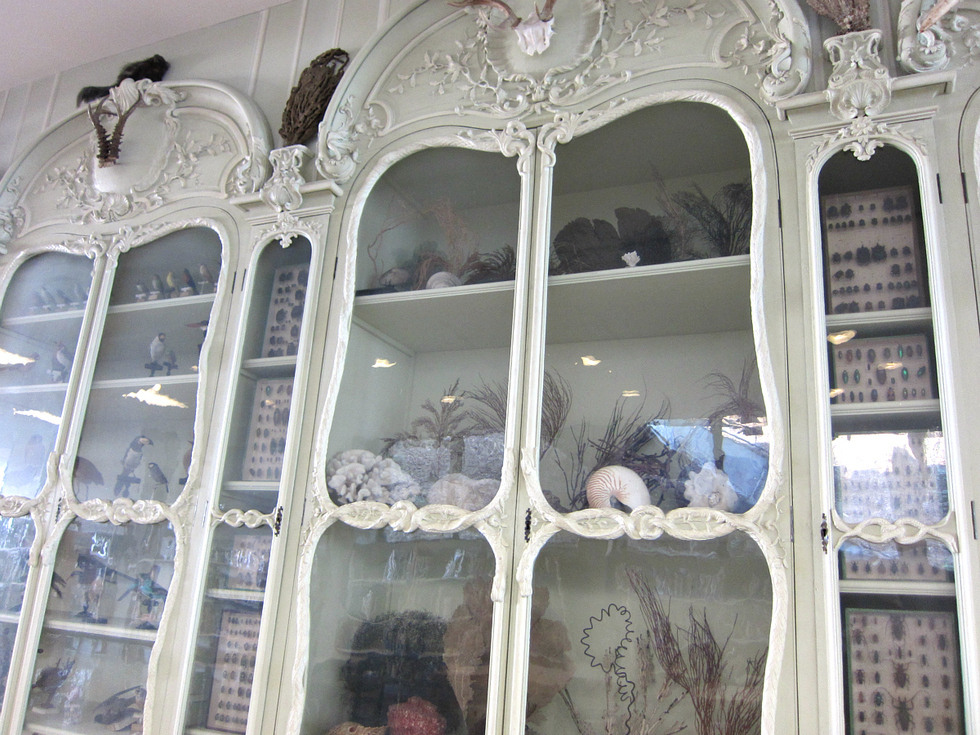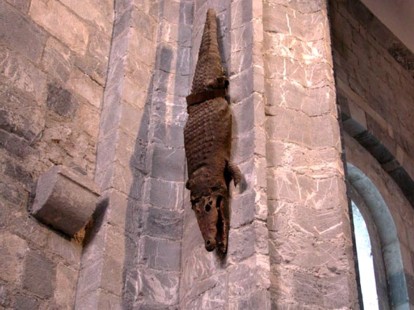The Cabinet of Curiosities at Manchester College

The Cabinet of Curiosities at Manchester College Le Cabinet de Curiosités de Joseph Bonnier de La Mosson http://www.atlasobscura.com/places/cabinet-of-joseph-bonnier-de-la-mosson
There is little I like better than a Cabinet of Curiosities, as a glance at the parcel-gilt-mounted nautilus cup and the stuffed Thylacine in my junk drawer would tell you. Once derided as dusty collections of curios better suited to a side-show exhibition or Barnum’s Museum, these chambers of storers have recently gained respect as the precursors of the modern museum. Taking full advantage, some museums have cleverly dusted off their two-headed goats, small-pox scabs, and unicorn’s horns to attract the wonder-seeking public. Here is a mention of a Museum Time Forgot, which you can visit today and a modern appraisal of the Cabinets’ histories and resurgence.
Accounts of the Cabinets of Curiosity of the past make for even more entertaining reading with their blend of the historic, mundane, zoological, and incredible. Dr. Beachcombing has written of one that had a collection of oddities from around the globe and even from the celestial realms, as it included what seems to have been billed as an archangel’s wing.

The Stuffed Crocodile of Saint-Bertrand-de-Comminges. http://www.users.globalnet.co.uk/~pardos/Resources/Crocodile2.jpg
The curiosities of Manchester College, a “Blue Coat School” for poor boys, were perhaps not as wide-ranging, but had considerable historical and zoological interest. They are a diverting list for today’s fortean.
The ‘Curiosities’ of Manchester College
On 12th October 1653, died at Clayton Hall, near Manchester, Humphrey Chetham, who bequeathed the large fortune which, though a gentleman by birth, he had made in trade, for the purpose of establishing a school for the education of forty poor children 0 Manchester, and also of founding a public library, which till recently was almost the only institution of the kind in Britain. The ‘college’ as the scholastic establishment and library are termed, was originally a religious foundation, but the buildings were in the sixteenth century sold to the Derby family, from whom they were purchased shortly after the death of Mr Chetham, by the trustees of the latter. The boys are boarded, clothed, and educated from about the age of six to fourteen, after which they are bound apprentices to some trade. Both in a philanthropic and antiquarian point of view, the college forms one of the most interesting public buildings in Manchester, contrasting so markedly, as it does, in its traditions of ancient times with the bustle of factory-life and the din of mills and machinery. No part of the structure strikes the visitor more forcibly in this respect than the library, which is open daily to the public, with an unlimited right to every one, whether a resident in the town or a stranger, of reading, within a room set apart for the purpose, any book in the collection. The only condition demanded is, that the reader shall enter in a book his name and address. The reading-room is an antique apartment, wainscoted with oak, and adorned with portraits of Humphrey Chetham, the founder, Luther, and other celebrities, and presenting altogether such a quaint and secluded appearance, that it is difficult for the visitor to realise the fact of his being near the centre of such a busy nineteenth-century city as Manchester.
Till within the last three or four years, an odd collection of what were termed ‘curiosities’ used to be exhibited in the library gallery attached to the college. The visitors were, or the most part, people from the country, who flocked thither to see the wonders of the place. A small fee for admission was charged, the duties of exhibitor being assumed by the college-boys in rotation, and certainly to a stranger the show-boy was the greatest curiosity there. with a loud, shrill voice, in the broad Lancashire dialect, and a tone of wearisome monotony, the boy, with or without a long wand, thus directed attention to the objects exhibited: ‘That’s th’ skeleton of a mon; that’s a globe ; that’s a talliscope; that’s a snake; over th‘ snake’s back‘s two watch-bills; them’s four ancient swooards; that wi’ a whoite haft onst belonged to General Wolfe; that’s th’ whip that th‘ snake was kilt wi’; that topmost’s a crocodoile ; that bottomost’s a halligator; that boot wonst belonged to Queen Elizabeth; that’s a Hindian pouch; that’s a ancient stiletto; that’s part o’ umphrey Cheetham’s armour; that wi’ th’ white feeace is a munkey; under th’ munkey’s a green lizard; side o’ th’ munkey’s a porpus’s skull; under the porpus’s skull ’s a halligator; under th’ halligator’s a turtle; them bows an‘ arrows belonged to th’ Injyans; that‘s a porpus’s head; them there’s various kinds o’ adders, werums, snakes, fishes, and vemenous creeturs; that albine piece was takken from th’ deead body of a Frenchmon, that was killed at th’ battle o’ Waterloo, that was fowt i’ th’ year eyteen hundert an’ fifteen; them ‘s a pair o’ eagle’s claws; that arrow belonged to one o’ th’ legions that fowt under th’ Duke o’ Richmunt at th’ battle o’ Bosworth Field, i’ th’ year 1485, when King Richurt th’ Third, king of Englund, was slain; them arrows wonst belonged to Robin Hood; that‘s a sea-hen; that’s a sea-weed; that‘s a unicorn fish; that’s part of a Hindian’s skull; that’s th’ top on it; that’s Oliver Crummell’s stone and tankard; that’s part on a. loadstone; them two pieces o’ wood was almanecks afoure printin’ was fun’ out; that’s a hairy mon; under th’ hairy mon’s a spakin-trumpet; side o’ th’ spaking-trumpet’s a sharks jaw-bone; that that’s leaning against th’ spaking-trumpet ’s Oliver Crummell‘s swooard; that’s a leather-bag ; side o’ th’ leather-bag’s two cokey-nut shells; side o’ th’ cokey-nut shell’s a porpus’s skull; side o’ th’ porpus’s head’s a pumpkin; over th’ pumpkin’s a turtle; side o’ th’ turtle’s a seaweed; that top ‘un’s a crocodile; under th’ crocodile’s a halligator; under th’ halligator’s a woman’s clog that was split by a thunner-bolt, an‘ hoo wasn’t hurt; side o’ th’ crocodile’s tail’s a sea-hen; side o’ sea-hen’s a Laplander’s snow-shoe; that in a box is th’ skeleton of a nightingale.’
This brought the show-boy and his gaping auditors to the door of the reading-room, the door of which being thrown open, the company entered to the great annoyance of the readers, and the lad would point out in the same loud, piercing voice, the various curiosities which the apartment contained, including the portrait of Chetham the founder, And finally pointing to the brilliantly painted and gilded cock on a bracket, would exclaim, by way of peroration, ‘That‘s th’ cock as crows when he smells roast-beef!’ The country-folk at this would stare more and gape wider, as if in momentary expectation of hearing Chanticleer, and then turn away, half disappointed, but consoling themselves with the supposition that just then there was no roast-beef within smelling distance. This ludicrous exhibition is, however, no longer one of the sights of Manchester College. The feoffees, feeling that it was scarcely in accordance with the cloistral, quiet, solemn aspect, and studious silence of the place, at length closed the show, and the curiosities have been removed to the Salford Royal Museum, Peel Park.
The Book of Days: A Miscellany of Popular Antiquities, Volume 2, October 13, Robert Chambers, 1864.

Portrait of Humphrey Chetham, from the library reading room
A poem about a visit to the collection (written in the same dialect), mentions also “stones taken out of a cow” and a table made up of as many pieces of wood as there are days in the year. There was also apparently a dramatic clock at the college featuring a winged, skeletal figure of death.
A few annotations: A watch-bill is a long-hafted weapon, something like a pike, halberd, or bill-hook. “Albine piece” is probably a misspelling for carbine piece. Oliver Cromwell’s “stone and tankard” is his “stone [ceramic] tankard]. But unless a “hary mon” is a monkey, the British Bigfoot may have been under our very noses until the mid-19th century.
Salford Royal Museum is now Salford Museum & Art Gallery with narry a sword in sight. I tried searching their artifacts collection, but failed to find any of the College’s curiosities. Too many museums zealously burned moth-eaten specimens–like the last stuffed dodo was said to have been, although Dr Karl Shuker has set the record straight. One hopes that in a dusty corner, somewhere in Manchester, still survive a gilded cockerell, a miraculous clog split by lightning, a stuffed halligator, Queen Elizabeth’s boot, or the skeleton of a nightingale in a box.
Any word from Manchester? chriswoodyard8 AT gmail.com
Rejoice! Reader Joe Nuttall has tracked down several of the curiosities, including General Wolfe’s sword, which somehow got left behind at the Museum. He writes:
Thanks for your page “The Cabinet of Curiosities at Manchester College” – i.e. Chets School and the attached Library. I hadn’t found that particular version of the curios, thanks to your page I have found the version you quote online here – https://archive.org/details/
Chris Woodyard is the author of The Victorian Book of the Dead, The Ghost Wore Black, The Headless Horror, The Face in the Window, and the 7-volume Haunted Ohio series. She is also the chronicler of the adventures of that amiable murderess Mrs Daffodil in A Spot of Bother: Four Macabre Tales. The books are available in paperback and for Kindle. Indexes and fact sheets for all of these books may be found by searching hauntedohiobooks.com. Join her on FB at Haunted Ohio by Chris Woodyard or The Victorian Book of the Dead. And visit her newest blog, The Victorian Book of the Dead.
